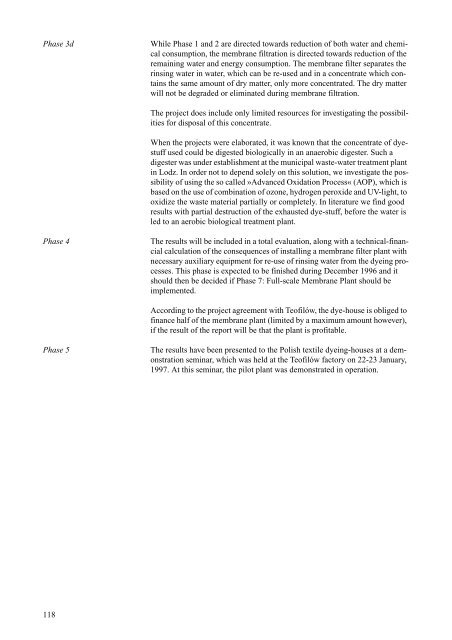Cleaner Technology Transfer to the Polish Textile ... - Miljøstyrelsen
Cleaner Technology Transfer to the Polish Textile ... - Miljøstyrelsen
Cleaner Technology Transfer to the Polish Textile ... - Miljøstyrelsen
You also want an ePaper? Increase the reach of your titles
YUMPU automatically turns print PDFs into web optimized ePapers that Google loves.
Phase 3d While Phase 1 and 2 are directed <strong>to</strong>wards reduction of both water and chemical<br />
consumption, <strong>the</strong> membrane filtration is directed <strong>to</strong>wards reduction of <strong>the</strong><br />
remaining water and energy consumption. The membrane filter separates <strong>the</strong><br />
rinsing water in water, which can be re-used and in a concentrate which contains<br />
<strong>the</strong> same amount of dry matter, only more concentrated. The dry matter<br />
will not be degraded or eliminated during membrane filtration.<br />
118<br />
The project does include only limited resources for investigating <strong>the</strong> possibilities<br />
for disposal of this concentrate.<br />
When <strong>the</strong> projects were elaborated, it was known that <strong>the</strong> concentrate of dyestuff<br />
used could be digested biologically in an anaerobic digester. Such a<br />
digester was under establishment at <strong>the</strong> municipal waste-water treatment plant<br />
in Lodz. In order not <strong>to</strong> depend solely on this solution, we investigate <strong>the</strong> possibility<br />
of using <strong>the</strong> so called »Advanced Oxidation Process« (AOP), which is<br />
based on <strong>the</strong> use of combination of ozone, hydrogen peroxide and UV-light, <strong>to</strong><br />
oxidize <strong>the</strong> waste material partially or completely. In literature we find good<br />
results with partial destruction of <strong>the</strong> exhausted dye-stuff, before <strong>the</strong> water is<br />
led <strong>to</strong> an aerobic biological treatment plant.<br />
Phase 4 The results will be included in a <strong>to</strong>tal evaluation, along with a technical-financial<br />
calculation of <strong>the</strong> consequences of installing a membrane filter plant with<br />
necessary auxiliary equipment for re-use of rinsing water from <strong>the</strong> dyeing processes.<br />
This phase is expected <strong>to</strong> be finished during December 1996 and it<br />
should <strong>the</strong>n be decided if Phase 7: Full-scale Membrane Plant should be<br />
implemented.<br />
According <strong>to</strong> <strong>the</strong> project agreement with Teofilów, <strong>the</strong> dye-house is obliged <strong>to</strong><br />
finance half of <strong>the</strong> membrane plant (limited by a maximum amount however),<br />
if <strong>the</strong> result of <strong>the</strong> report will be that <strong>the</strong> plant is profitable.<br />
Phase 5 The results have been presented <strong>to</strong> <strong>the</strong> <strong>Polish</strong> textile dyeing-houses at a demonstration<br />
seminar, which was held at <strong>the</strong> Teofilów fac<strong>to</strong>ry on 22-23 January,<br />
1997. At this seminar, <strong>the</strong> pilot plant was demonstrated in operation.

















